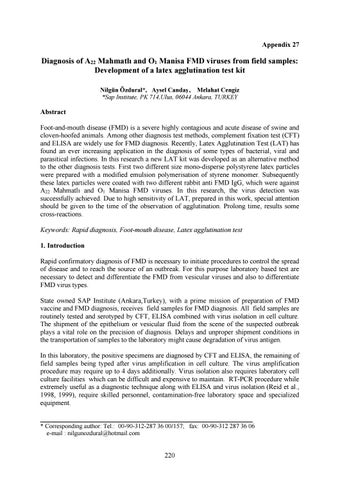Appendix 27
Diagnosis of A22 Mahmatlı and O1 Manisa FMD viruses from field samples: Development of a latex agglutination test kit Nilgün Özdural*, Aysel Candaş , Melahat Cengiz *Sap Institute, PK 714,Ulus, 06044 Ankara, TURKEY
Abstract Foot-and-mouth disease (FMD) is a severe highly contagious and acute disease of swine and cloven-hoofed animals. Among other diagnosis test methods, complement fixation test (CFT) and ELISA are widely use for FMD diagnosis. Recently, Latex Agglutination Test (LAT) has found an ever increasing application in the diagnosis of some types of bacterial, viral and parasitical infections. In this research a new LAT kit was developed as an alternative method to the other diagnosis tests. First two different size mono-disperse polystyrene latex particles were prepared with a modified emulsion polymerisation of styrene monomer. Subsequently these latex particles were coated with two different rabbit anti FMD IgG, which were against A22 Mahmatlı and O1 Manisa FMD viruses. In this research, the virus detection was successfully achieved. Due to high sensitivity of LAT, prepared in this work, special attention should be given to the time of the observation of agglutination. Prolong time, results some cross-reactions. Keywords: Rapid diagnosis, Foot-mouth disease, Latex agglutination test 1. Introduction Rapid confirmatory diagnosis of FMD is necessary to initiate procedures to control the spread of disease and to reach the source of an outbreak. For this purpose laboratory based test are necessary to detect and differentiate the FMD from vesicular viruses and also to differentiate FMD virus types. State owned SAP Institute (Ankara,Turkey), with a prime mission of preparation of FMD vaccine and FMD diagnosis, receives field samples for FMD diagnosis. All field samples are routinely tested and serotyped by CFT, ELISA combined with virus isolation in cell culture. The shipment of the epithelium or vesicular fluid from the scene of the suspected outbreak plays a vital role on the precision of diagnosis. Delays and unproper shipment conditions in the transportation of samples to the laboratory might cause degradation of virus antigen. In this laboratory, the positive specimens are diagnosed by CFT and ELISA, the remaining of field samples being typed after virus amplification in cell culture. The virus amplification procedure may require up to 4 days additionally. Virus isolation also requires laboratory cell culture facilities which can be difficult and expensive to maintain. RT-PCR procedure while extremely useful as a diagnostic technique along with ELISA and virus isolation (Reid et al., 1998, 1999), require skilled personnel, contamination-free laboratory space and specialized equipment. ______________________________________________________________
* Corresponding author: Tel.: 00-90-312-287 36 00/157; fax: 00-90-312 287 36 06 e-mail : nilgunozdural@hotmail.com
220






